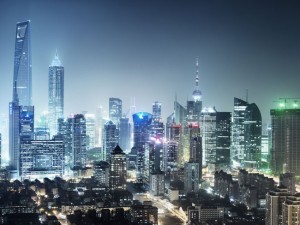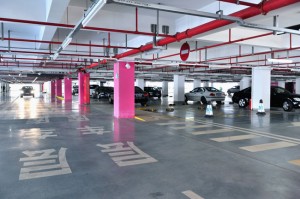Commercial Properties – Part 3 商业地产(下)
By T.K.
We are continuing to look deeper into some major types of commercial properties in this issue, including offices, hotels, and car parks.
Offices
On offices, we believe investors would still target at the Grade-A offices in the Tier-1 cities such as Beijing and Shanghai where Multi-National Companies (MNCs) are crowding into.
We all witnessed that there are more and more modernized and taller office buildings completed in the past decade. However, the vacancy rates are actually improving. Beijing improved from 9.1% to 5.0% during 2004 and 2013 while Shanghai has been kept at about 6% over the mentioned period.
On the back of increasing supply and concerns on the slowing growth of the economy in China, some of the investors would question about the value of investment in office. Let’s have brief look at the rate of return. In 2004, the return on Grade-A offices in Beijing and Shanghai were over 8%, compared to 6% as of end-2013. This is higher than that of the residential units but still not as sexy as other high yield bond products in the market. The return is similar to the wealth management product offered by most of the banks, why bother to invest in the office market?
As mentioned in the previous issue, the offices market is relatively stable and resilient. Moreover, despite the slower growth of economy in China, its growth is still than most of the other developed countries in the world. Hence, investors could opt for offices as risk diversion. Moreover, there is a good potential for capital gain as well.
Hotel
This is another industry that has been developed at a high speed over the past few years with multinational operators rushing into the China market to set up their networks. Industry data showed that the total numbers of star rated hotel rooms have been declining but that of the 5-star hotels have been increasing. Hence the average occupancy rate among the 5-star hotels dropped to 56% in 2013, representing 4ppt drop from 2012. In addition, the average room rates among the 5-star hotels have been standing at about RMB700 in the past three years. Such observation suggested that the increasing supply and declining occupancy rates are exerting pressures on the room rate.
However, the data gives the operators confidence as the domestic tourism market has been steadily growing. From 2007 to 2013, total number of domestic travelers increased at a compound annual growth rate (CAGR) of 12.4% to 3.26 billions. During the same period, the total revenue from domestic travel increased at a faster CAGR of 23% to RMB2.63 billions. Moreover, with better developed highways and the toll-free arrangement at long holidays, and also the increasing ownership of cars, weekend and holiday travelers will creating a substantial demand to the hotel industry.
Hotel operators are looking forward to the growing domestic tourism as well as the growing middle-income group. Hence they are setting up the network to capture this opportunity.
Car park
The automobile industry, not only primary market but also the pre-owned cars trading and car rental companies are all rapidly developing in recent years. With the growing car ownership and usages, the demand on parking spaces will then increase at a fast pace.
If you own a car, you must notice that it is more difficult for you to find a space to park your cars. We feel this in Shanghai and also seeing that, the parking fee has becoming much more expensive. Previously it was charging RMB10 per hour and many of them are charging 50% more at RMB15 per hour now. Moreover, many of the large malls offered free parking in about 3 years ago but now, even you are willing to pay, and it is not easy to get a place for your car.
In Westgate Mall of Shanghai, the mall operator is using double decker parking devices in their underground car park but due to the popular location, car owners still have to queue for some time to get a place.
China is the number one nation in the world in terms of car sales. Car makers are trying to expand their business here by bringing in more localization of the plant to lower the cost. In addition, the loosening of the single child policy could be a driving factor for further growing of the car ownership. All in all, car parking spaces will be in great demand and the fees are believed to be increased. Hence it would be an attractive investment tool.
我们今期将继续探讨一些主要的商业地产项目,包括办公楼、酒店及停车场。
办公楼
我们相信甲级写字楼的投资者仍然会把集中力放在如北京和上海等一线城市,因为跨国公司较多,而且也较容易寻找有实力的租户。
大家都看到在过去的十年,一座座现代化的摩天办公大楼陆续落成,而空置率却没有因供应增加而上升,反而比以前还要低。在北京,空置率在2004年和2013年间由9.1%至改善至5.0%,而上海则一直保持在6%左右。
在供应增加和中国经济增长放缓的同时,也许有些投资者会质疑有关办公楼的投资价值。我们简要地回顾一下回报率。 2004年,在北京和上海甲级写字楼的回报率都高于8%,而2013年底约为6%。这虽然比住宅单位为高,但和市场上其他高收益债券产品相比则显得不够有吸引力。这样的回报率大概和大多数银行提供的理财产品类似,那为什么还要投资于写字楼市场?
如上期提及,办公楼市场相对稳定和有防守性。此外,尽管中国的经济增长放缓,其增长速度仍然比大多数发达国家为高。因此,投资者可以选择办公楼以分散风险。此外,若干年后也很有可能享受到资本的增值。
酒店
这是另一个近年高速发展的行业。不少跨国酒店集团都纷纷涌进国内市场分一杯羹。行业数据显示,星级酒店的客房数量在过去两年有下降的现象,但五星级酒店的客房数量却在增加。因此,五星级酒店的平均入住率在2013年下降至56%,比2012年低了4个百分点。另外,五星级酒店的平均房价在过去三年保持稳定,约为人民币700元。这显示了供应的增加和入住率减少给平均房价带来了压力。
然而,国内旅游市场的数据却为酒店集团带来了希望。从2007年到2013年,国内游客总人数的复合年均增长率为12.4%,增长至32.6亿人次。在同一时期,国内旅游总收入取得更高的复合增长率,以23%的速度增长至26.3亿元人民币。此外,更完善的公路建设,长假期间实施的高速公路免收费计划,以及汽车拥有量的增加,都令假日和周末的出游人数上升,从而为酒店业创造大量需求。
酒店营运商都期待着国内旅游市场不断发展和中等收入群体的增长。因此,他们正在建立网络,以捕捉这个机会。
停车场
汽车行业,不论新车、二手车和租车市场近年迅速发展。随着不断增长的汽车保有量,随之而来的就是停车位需求的加速。
如果你是有车一族,你一定会感觉到现在找个停车位比几年前难多了。我们在上海就深深体会到这一点,同时也见证了停车费的飞涨。以前大部分地方的收费是每小时10元人民币,现在很多地方都收每小时15元人民币了,上升了50%。此外,大约3年前有不少大型商场提供免费停车的优惠。现在,即使你愿意付钱,也不是那么容易找得到停车的地方。
在上海的梅龙镇广场,商场运营商在地下停车室使用双层停车设备以增加容量,但由于其黄金地理位置,车主们仍然要轮候一段时间才能把车停进去。
中国是世界汽车销量第一的国家。汽车制造商正试图在这里拓展业务增加市场份额,方法之一是提高国产化以降低成本。此外,放松了一孩政策也可能会进一步增加汽车拥有量。总而言之,停车位的需求将会大量增加而停车费也会继续上涨。因此,这将是一个有吸引力的投资工具。



You must be logged in to post a comment Login